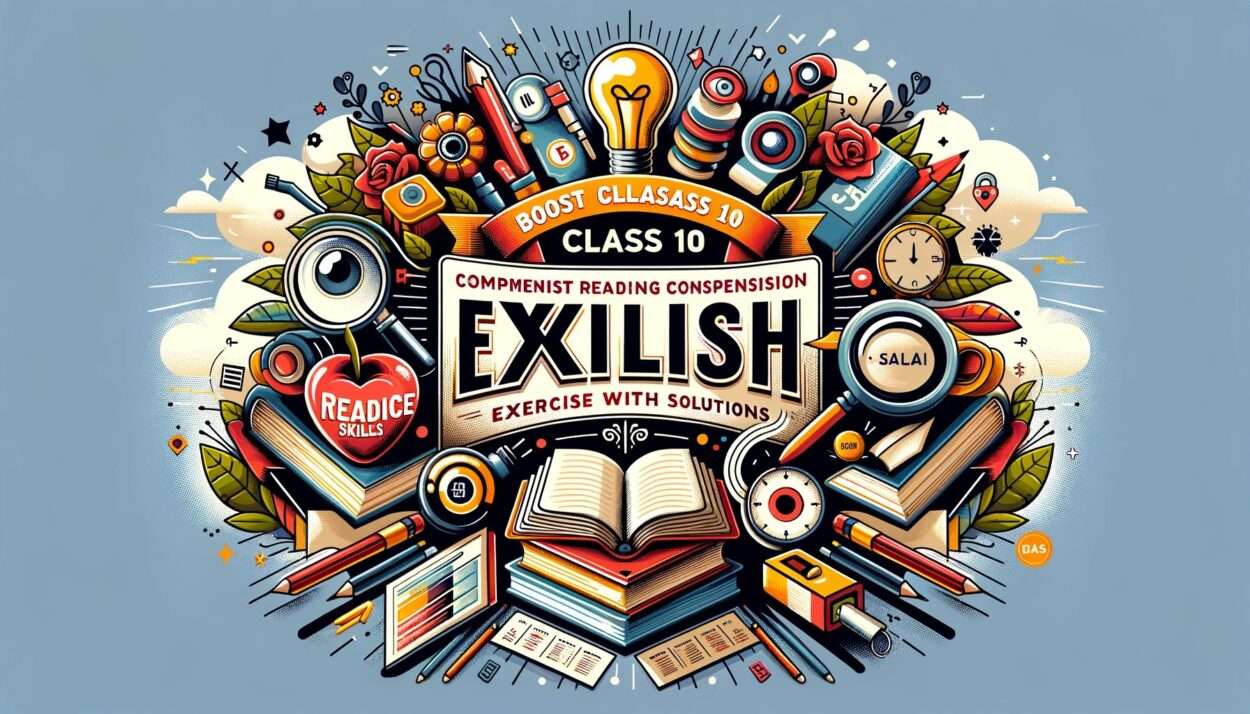
Boost Class 10 English Skills: Comprehensive Reading Comprehension Exercise with Solutions

Introduction
Reading comprehension is a cornerstone of English language proficiency, particularly for students in Class 10. It’s not just a vital skill for exams but is fundamental for overall language development. This article delves deep into how students can enhance their reading comprehension abilities to perform better in their board exams.
Understanding Reading Comprehension
Reading comprehension is the ability to read text, process it, and understand its meaning. In Class 10 English exams, it tests how well students can interpret, analyze, and infer from the material they have read.
Section 1: Developing Strong Reading Habits
Regular reading is critical in developing comprehension skills. It’s essential to choose a variety of reading materials, including books, articles, and journals. Diverse genres introduce students to different writing styles and contexts, enhancing their ability to understand and interpret various texts.
Techniques for Effective Reading
Reading strategies are crucial for comprehension. Skimming (quickly reviewing the text to get the gist) and scanning (looking for specific information) are essential techniques. Critical reading involves analyzing the content, understanding its nuances, and reading between the lines. Effective note-taking and annotating can also aid in better understanding and remembering the content.
Breaking Down the Comprehension Process
The comprehension process involves three stages:
- Pre-reading: Preview the text to get an idea of what it’s about. Set a purpose for reading to focus your understanding.
- Active Reading: Engage with the text by questioning, visualizing, and making connections. This deeper engagement helps in better understanding.
- Post-reading: Summarize the text and review key points to consolidate understanding.
Tackling Different Types of Questions
Reading comprehension questions in exams can be direct, inferential, or analytical. For direct questions, locate the specific information in the text. Inferential questions require reading beyond the literal meaning, and analytical questions ask for evaluations and forming opinions.
Example Question and Solution:
Question: What is the author’s tone in the second paragraph of the passage?
Solution: Analyze the choice of words and the overall message conveyed in the paragraph to determine the author’s tone.
Enhancing Vocabulary and Language Skills
A robust vocabulary aids in understanding and interpreting texts. Regular reading, using flashcards, and referring to dictionaries can help in building vocabulary. Grammar is also crucial for understanding sentence structure and meaning.
Time Management during Exams
Effectively allocate time for reading and answering questions. Develop the skill of reading quickly yet comprehensively. Practice exercises with time limits to improve speed and efficiency.
Practice and Sample Exercises
Regular practice is key. Use previous year papers and sample texts for practice. Try different levels of difficulty to challenge and improve your skills.
Example Exercise: Reading Comprehension
Read the following passage:
Once there was a small village that sat at the edge of a river. The people of the village were hardworking and lived simple lives. One day, a wise old man visited the village. He noticed that despite their hard work, the villagers did not seem truly happy. The old man gathered everyone and told them a tale of a magical tree that grew on the other side of the river. The tree, he said, bore fruit that brought happiness to whoever ate it. Excited by the prospect, the villagers decided to build a bridge to cross the river.
It took them several months, but the bridge was finally completed. The villagers crossed the river and found the tree just as the old man had described. They ate the fruit and indeed found happiness. However, they soon realized that the happiness was not from the fruit, but from the sense of accomplishment and unity they felt from building the bridge and working together as a community.
Questions:
- What was the main problem faced by the villagers?
- Answer: Despite their hard work, the villagers did not seem truly happy.
- What did the wise old man tell the villagers?
- Answer: He told them about a magical tree on the other side of the river that bore fruit which could bring happiness.
- How did the villagers reach the tree?
- Answer: The villagers built a bridge to cross the river to reach the tree.
- What realization did the villagers come to after eating the fruit?
- Answer: They realized that their happiness came from the sense of accomplishment and unity from building the bridge and working together, not from the fruit itself.
- What is the moral of the story?
- Answer: The moral of the story is that true happiness and fulfillment often come from hard work, collaboration, and a sense of community, rather than external sources.
Conclusion
To master reading comprehension, continuous practice, and a strategic approach to reading and understanding texts are crucial. Seek help if needed and remember to stay calm and focused during the exam.
Appendix: Additional Resources
For further practice, refer to recommended reading materials and websites. Apps and tools for improving reading comprehension can also be beneficial.